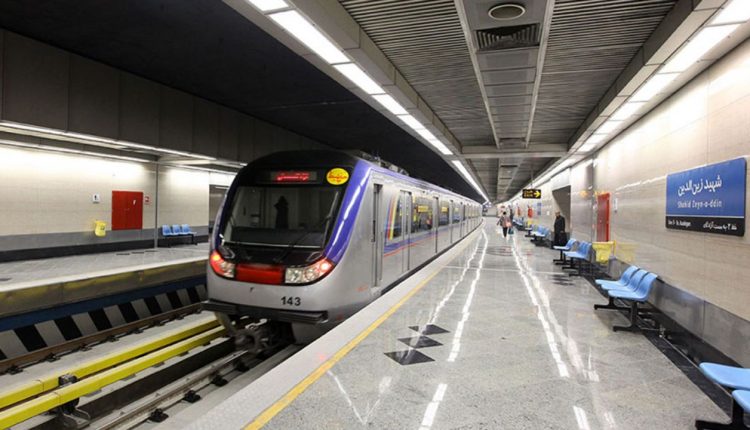The money is to be injected in subway projects underway and plans for upgrading the capital’s aging urban bus fleet.
Anoushiravan Mohseni Bandpei, Tehran's governor general, said the capital's urban transportation system is in dire need of renovation and development, IRNA reported.
"The financial support can help Tehran Municipality streamline the public transport network’s expansion," Financial Tribune quoted Bandpei as saying.
He underlined other sources of TM's income, including road toll and urban taxes that account for 35 trillion rials ($275.5 million), and said, "The Plan and Budget Organization is also mulling a plan to offer cheap loans to municipalities of major Iranian cities, including the capital."
The loans are to be spent specifically on improving urban means of transportation, he added.
Bandpei said the country and all its sectors are facing economic hardships and budget cuts these days, urging TM to wisely manage its financial resources and give an immediate priority to the expansion of subway network and the optimization of buses and cab fleet in the sprawling city.
Current Status
According to Tehran Municipality, over 1,000 subway cars are currently operating in the capital's urban subway system, 30% of which need to be upgraded.
The capital's subway stretches over 220 kilometers and comprises seven lines (1 to 7) with nearly 120 stations. Lines 6 and 7 are yet to become fully operational.
Subway commute has increased significantly in Tehran in recent years and now four million people use the trains every day. TM expects the number to surge by 25% after subway lines 6 and 7 are up and running.
But this is definitely not enough for Tehran where, according to statistics, over 15 million people commute daily, many from the surrounding cities and towns.
The number of buses operating in Tehran hardly reaches 6,000, half the number required for offering acceptable transportation services in the megacity.
Experts say the average age of the fleet is over 11 years, such that 50% of the buses plying the streets of Tehran are dilapidated and fit for the scrap-yard.
These old buses have numerous technical flaws and cause inconvenience to passengers, apart from worsening the air pollution suffocating Tehran’s residents.
Toxic Emissions in the Air
Officials believe that the underdeveloped urban transportation has a direct impact on air quality, which Tehran’s citizens witnessed in the past several days.
Over the past week, air quality index hit an emergency level and compelled officials to take immediate remedial measures, from shutting down the schools to limiting the operation of industrial units in the city. However, the lack of a comprehensive and effectual plan to control the problematic air pollution has always been felt.
Speaking at a Sunday meeting with urban managers, Mohsen Hashemi Rafsanjani, chairman of Tehran City Council, said the smog enveloping the city can be only partly attributed to uncontrollable factors like weather condition, air temperature and geomorphologic features of the city.
"The determining factors are toxic emissions released by dilapidated and substandard vehicles plying the streets," Hashemi said, emphasizing that they can be controlled by modifying the society's driving culture.
The Tehran City Council chief noted that regulating smog inducing motorcycles, taxis and buses, and devising a plan to phase out dilapidated vehicles, expanding the subway, setting up an efficient traffic scheme and raising public awareness about driving rules and health effects of air pollution exposure should be carried out simultaneously.
"Only then we can expect the successful obliteration of urban challenges like air pollution and traffic congestion," he added.
Hashemi warned urban managers about the deteriorating status of urban issues and said things will get much worse if no workable measure is taken.
Call for Clean Air Act
Commenting on the deteriorating air pollution in Tehran during the past week, Massoud Tajrishi, the head of Department of Environment's Office for Human Environment, said the dangerously poor air quality was expected.
"Domestic carmakers produced around 800,000 vehicles in the last Iranian year [ended March 20, 2019], with half of the customers living in the capital. Therefore, such a poor air quality is quite natural," he told IRNA.
Tajrishi said newspapers have been writing about air pollution in the metropolis for the past three decades.
He also noted that the city was ecologically pressured by the population growth and its environmental consequences during the 1990s.
“In case proposed solutions like Clean Air Act were fully operational, the situation concerning air quality in Tehran would have been different today,” he added.
The 35-article Clean Air Act drawn up by DOE as an integrated approach to curb air pollution was passed by the parliament on July 16, 2017, after gathering dust in the previous Majlis for over a year.
The act singles out inefficient vehicles, substandard fuels, industrial activities and dust storms as the major sources of air pollution in the country.
It tasks different administrations, including DOE's Office for Human Environment, Interior Ministry and TM, with specific actions in line with the objective.
CAAs full enactment depends on related organizations' preparation of regulations, which are pending.
“The bill many not be ideal, but it can do good in curbing the uncontrollable air pollution facing Tehran these days,” Tajrishi said.
As the fourth leading cause of premature deaths worldwide, toxic air leads to heart disease and stroke, lung cancer and respiratory infections.
Given the absence of long-term initiatives and the lack of determination to combat air pollution on a war footing, citizens will continue to suffer in the foreseeable future in Iranian metropolises.


